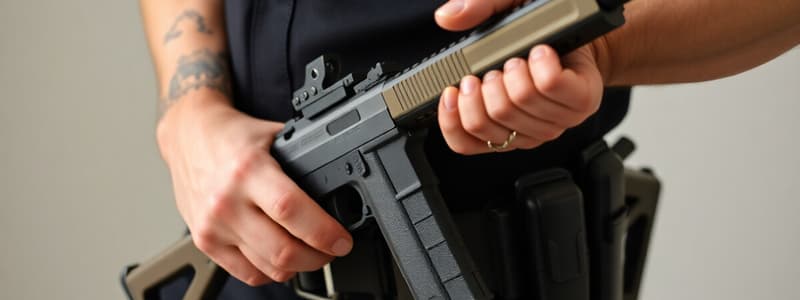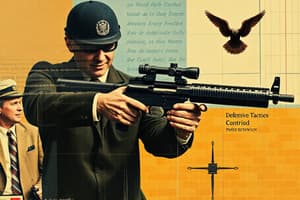Podcast
Questions and Answers
What is the first step to take when a subject grabs your holstered handgun?
What is the first step to take when a subject grabs your holstered handgun?
- Adjust your stance to maintain balance. (correct)
- Deliver strikes to appropriate target areas.
- Create distance from the subject.
- Apply upward pressure on the subject's hand.
Which technique should be used when a subject grabs a drawn handgun's barrel?
Which technique should be used when a subject grabs a drawn handgun's barrel?
- Arm wrestling technique.
- Overhead hand strike technique.
- Cradle handgun retention. (correct)
- Holstered handgun retention.
When performing the cradle handgun retention technique, what is the correct position for your non-weapon arm?
When performing the cradle handgun retention technique, what is the correct position for your non-weapon arm?
- Resting on your hip for better balance.
- Holding the barrel of the handgun firmly.
- Under the handgun and the subject's hand. (correct)
- At your side for minimal movement.
What action is NOT recommended when a subject grabs your holstered handgun?
What action is NOT recommended when a subject grabs your holstered handgun?
What is the purpose of widening your stance when responding to a subject grabbing your drawn handgun?
What is the purpose of widening your stance when responding to a subject grabbing your drawn handgun?
What is the primary goal of weapon retention techniques?
What is the primary goal of weapon retention techniques?
Which technique is specifically mentioned for protecting holstered intermediate weapons?
Which technique is specifically mentioned for protecting holstered intermediate weapons?
What is an important step in the holstered intermediate weapon retention technique?
What is an important step in the holstered intermediate weapon retention technique?
What role do verbal commands play in weapon retention techniques?
What role do verbal commands play in weapon retention techniques?
What is the first step when executing drawn baton retention?
What is the first step when executing drawn baton retention?
In drawn baton retention, what movement is used to release the subject's grip?
In drawn baton retention, what movement is used to release the subject's grip?
Why should the holstered handgun retention technique only be used if the holster is affixed to the belt?
Why should the holstered handgun retention technique only be used if the holster is affixed to the belt?
Which of the following is NOT a technique mentioned for weapon retention?
Which of the following is NOT a technique mentioned for weapon retention?
Flashcards
Weapon Retention
Weapon Retention
Techniques to prevent a suspect from taking an officer's weapon during a confrontation.
Reactionary Gap
Reactionary Gap
The space between the officer and the suspect, crucial for preventing disarming.
Holstered Intermediate Weapon Retention
Holstered Intermediate Weapon Retention
Technique for retaining weapons like batons or chemical agents when holstered.
Drawn Baton Retention
Drawn Baton Retention
Signup and view all the flashcards
Holstered Handgun Retention
Holstered Handgun Retention
Signup and view all the flashcards
Front or Rear Grab
Front or Rear Grab
Signup and view all the flashcards
Appropriate Target Areas
Appropriate Target Areas
Signup and view all the flashcards
Verbal Commands
Verbal Commands
Signup and view all the flashcards
Holstered Handgun Retention
Holstered Handgun Retention
Signup and view all the flashcards
Drawn Handgun Retention
Drawn Handgun Retention
Signup and view all the flashcards
Reactionary Gap
Reactionary Gap
Signup and view all the flashcards
Verbal Commands
Verbal Commands
Signup and view all the flashcards
Cradle Technique
Cradle Technique
Signup and view all the flashcards
Study Notes
Weapon Retention Techniques
- Goal: Demonstrate safe and effective methods of retaining weaponry during a confrontation.
- Officer Actions: Control weapons, maintain reactionary gap, protect weapons and vital areas during close-quarter combat.
- Techniques Covered:
- Holstered intermediate weapon retention
- Drawn baton retention
- Holstered handgun retention
- Drawn handgun retention
Holstered Intermediate Weapon Retention
- Applicable Weapons: Batons, chemical agents, CEWs
- Technique Steps:
- Maintain balance.
- Secure weapon by applying downward pressure to weapon/subject's hand in holster.
- Strike appropriate targets while rotating body to break hold.
- Follow up with appropriate actions (see figure 4-80).
Drawn Baton Retention
- Applicable Grabs: One-handed and two-handed
- Technique Steps:
- Maintain balance.
- Rotate baton end upward and from left to right to release grip.
- Pull baton back and away.
- Follow up with appropriate actions (see figure 4-81).
Holstered Handgun Retention
- Equipment: Holster firmly affixed to belt.
- Technique Steps:
- Maintain balance.
- Secure weapon by applying downward pressure to firearm/subject's hand in holster.
- Strike target areas while rotating body to break hold.
- Follow up with appropriate actions (see figure 4-82).
Drawn Handgun Retention
- Applicable Grabs: Drawn handgun's barrel
- Technique Steps:
- Widen stance, lower center of gravity.
- Bring handgun closer to chest.
- Wrap non-weapon arm under handgun and subject's hand, clamp to chest.
- Lever gun barrel upward to release grasp.
- Create distance from subject by stepping back, pulling handgun downward.
- Follow up with appropriate action (see figure 4-83).
Studying That Suits You
Use AI to generate personalized quizzes and flashcards to suit your learning preferences.




